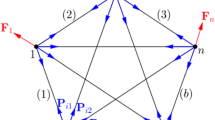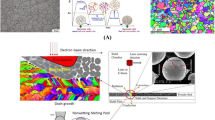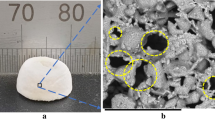Abstract
Laguerre mosaics have been an important modeling approach in astronomy, physics, crystallography, geology and mathematics for several decades. In materials science, they are used as models for cellular and polycrystalline materials, networks and cell foams. In this study, Laguerre mosaics are used to model the three-dimensional internal mineral microstructure of complex ores. Here, the difficulties arise in representing and simulating these microstructure mosaics for dimensions larger than two. Therefore, this manuscript introduces a general workflow for the representation in arbitrary dimensions and presents a realization of this workflow using generalized maps for representation in two and three dimensions. With this approach, lower-dimensional components such as cells, facets, edges and vertices can be accessed directly, which enables us to efficiently create the mosaics and derive statistics, plane sections and new mosaic models by intersection. Furthermore, it allows for easy deduction of the dual mosaic and efficient storage. The mineral microstructure of complex ores can be very complicated and often shows a highly fractal structure. Therefore, numerical modeling and representation of these microstructures is challenging. The proposed approach for Laguerre mosaic creation and representation is successfully applied to the modeling of mineral microstructures and particles. These microstructure models are used for mineral processing simulations in order to determine optimal processing strategies to conserve valuable resources.











Similar content being viewed by others
Notes
Here: Intel\(^{{\textregistered }}\) Xeon\(^{{\textregistered }}\) E3-1245 v5, 3.5 GHz, QuadCore, Java version 1.8.0_162_b12.
References
Aurenhammer F (1987) Power diagrams: properties, algorithms and applications. SIAM J Comput 16:78–96
Aurenhammer F, Klein R (2000) Voronoi diagrams. In: Sack JR, Urrutia J (eds) Handbook of computational geometry. Elsevier, Amsterdam, pp 201–290
Ballani F, Daley DJ, Stoyan D (2006) Modelling the microstructure of concrete with spherical grains. Comput Mater Sci 35:399–407
Barber CB, Dobkin DP, Huhdanpaa H (1996) The quickhull algorithm for convex hulls. ACM Trans Math Softw 22:469–483
Boguslawski P (2011) Modelling and analysing 3D building interiors with the dual half-edge data structure. Dissertation, University of Glamorgan
Brisson E (1993) Representing geometric structures in d dimensions: topology and order. Discrete Comput Geom 5:387–426
Brown KQ (1979) Voronoi diagrams from convex hulls. Inf Process Lett 9:223–228
Caumon G, Lévy B, Castanié L, Paul JC (2005) Visualization of grids conforming to geological structures: a topological approach. Comput Geosci 31:671–680. https://doi.org/10.1016/j.cageo.2005.01.020
Damiand G, Lienhardt P (2014) Combinatorial maps: efficient data structures for computer graphics and image processing. CRC Press, Boca Raton
Damiand G, Teillaud M (2014) A generic implementation of dD combinatorial maps in CGAL. Procedia Eng 82:46–58. https://doi.org/10.1016/j.proeng.2014.10.372
Fan Z, Wu Y, Zhao X, Lu Y (2004) Simulation of polycrystalline structure with voronoi diagram in laguerre geometry based on random closed packing of spheres. Comput Mater Sci 29:301–308
Fandrich R, Gu Y, Burrows D, Moeller K (2007) Modern SEM-based mineral liberation analysis. Int J Miner Process 84:310–320. https://doi.org/10.1016/j.minpro.2006.07.018
Feng X, Wang Y, Weng Y, Tong Y (2013) Compact combinatorial maps: a volume mesh data structure. Graph Models 75:149–156
Goldman RN (1991) IV.1—Area of planar polygons and volume of polyhedra. In: Arvo J (ed) Graphics gems II. Morgan Kaufmann, San Diego, pp 170–171. https://doi.org/10.1016/B978-0-08-050754-5.50043-8
Guibas L, Stolfi J (1985) Primitives for the manipulation of general subdivisions and the computation of voronoi. ACM Trans Graph 4:74–123
Jamin C, Pion S, Teillaud M (2018) CGAL 4.12.1 Manual – 3D Triangulations. CGAL Editorial Board. https://doc.cgal.org/4.12.1/Manual/packages.html#PkgTriangulation3Summary. Accessed 29 Oct 2019
Kanaun S, Tkachenko O (2006) Mechanical properties of open cell foams: simulations by Laguerre tesselation procedure. Int J Fract 140:305–312
Kremer M, Bommes D, Kobbelt L (2013) OpenVolumeMesh—a versatile index-based data structure for 3D polytopal complexes. In: Jiao X, Weill JC (eds) Proceedings of the 21st international meshing roundtable. Springer, Berlin, pp 531–548
Kumar S, Kurtz SK (1994) Simulation of material microstructure using a 3D voronoi tesselation: calculation of effective thermal expansion coefficient of polycrystalline materials. Acta Metall Mater 42:3917–3927
Lautensack C (2007) Random Laguerre tessellations. Dissertation, Universität Karlsruhe, Germany
Lautensack C, Zuyev S (2008) Random Laguerre tessellations. Adv Appl Probab 40:630–650
Lévy B, Mallet JL (1999) Cellular modeling in arbitrary dimension using generalized maps (technical report). Gocad consortium – ISA-GOCAD (Inria-Lorraine/CNRS), ENSG, rue du doyen Marcel Roubeault, 54500 Vandoeuvre, France
Lienhardt P (1994) N-dimensional generalized combinatorial maps and cellular quasi-manifolds. Int J Comput Geom Ap 4:275–324
Mallet JL (2002) Cellular partitions. In: Mallet JL (ed) Geomodelling. Oxford University Press, New York, pp 27–96
Matérn B (2013) Spatial variation. Springer, New York
Menzel P, Teichmann J, Pech S, van den Boogaart KG (2017) Java implementation of the generalized maps concept. GitHub. https://github.com/HZDR-FWGB/Gmap. Accessed 29 Oct 2019
Muller DE, Preparata FP (1978) Finding the intersection of two convex polyhedra. Theor Comput Sci 7:217–236
Pérez-Barnuevo L, Pirard E, Castroviejo R (2012) Textural descriptors for multiphasic ore particles. Image Anal Stereol 31:175–184
Pérez-Barnuevo L, Pirard E, Castroviejo R (2013) Automated characterisation of intergrowth textures in mineral particles. A case study. Miner Eng 52:136–142
Redenbach C (2009) Microstructure models for cellular materials. Comput Mater Sci 44:1397–1407
Schlottmann M (1993) Periodic and quasi-periodic laguerre tilings. Int J Mod Phys B 7:1351–1363
Schneider R (2014) Convex bodies: the Brunn–Minkowski theory. Cambridge University Press, Cambridge
Schneider R, Weil W (2008) Stochastic and integral geometry. Springer, Berlin
Sobhanpanah C (1989) Extension of a boundary representation technique for the description of n dimensional polytopes. Comput Graph 13:17–23
Teichmann J, van den Boogaart KG (2016) Efficient simulation of stationary multivariate Gaussian random fields with given cross-covariance. Appl Math 7:2183–2194
The CGAL Project (2018) CGAL 4.12.1 Manual. CGAL Editorial Board. https://doc.cgal.org/4.12.1/Manual/packages.html. Accessed 29 Oct 2019
Welzl E (1991) Smallest enclosing disks (balls and ellipsoids). In: Maurer H (ed) New results and new trends in computer science. Springer, Berlin, pp 359–370
Yvinec M (2018) CGAL 4.12.1 Manual – 2D Triangulation. CGAL Editorial Board. https://doc.cgal.org/4.12.1/Manual/packages.html#PkgTriangulation2Summary. Accessed 29 Oct 2019
Acknowledgements
We thank the editor and the reviewers for suggestions that improved our manuscript. The presented study was part of two projects funded by the BMBF (Federal Ministry of Education and Research, Germany): AMREP and REE NAM XE. Both projects are part of the research program CLIENT ’International Partnerships for Sustainable Technologies and Services for Climate Protection and the Environment’. Additional thanks go to our institute colleagues Dr. A. Elsner and Dr. habil. R. Tolosana-Delgado for scientific support and input.
Author information
Authors and Affiliations
Corresponding author
Additional information
Peter Menzel: Previously at Helmholtz Institute Freiberg for Resource Technology.
The presented study was funded by the BMBF (Federal Ministry of Education and Research, Germany) within two projects: AMREP (Funding No. 033R119B) and REE NAM XE (Funding No. 3122282131)
Algorithm for Identification of Individual Cells as Intersection Candidates
Algorithm for Identification of Individual Cells as Intersection Candidates
In practice, microstructure mosaic realizations can contain a very high number of individual n-cells. For particle sampling based on fracture mosaics, each cell has to be identified as either completely outside, inside or on an intersecting n-cell. Naively, this would mean testing each of the N cells from the microstructure mosaic with all M cells from the fracture mosaic for intersection. This can be avoided by applying a so-called collection algorithm that defines i-cells as intersection candidates. The general n-dimensional method leads recursively back to the two-dimensional case as described in what follows.
Let \(\mathcal {C}_1 = \{\mathcal {E}_1, \mathcal {V}_1\}\) be a polygon and \(M_2 = \{\mathcal {C}_2, \mathcal {E}_2, \mathcal {V}_2\}\) be a mosaic in \(\mathbb {R}^2\) with cells \(\mathcal {C}\) (2-cells), edges \(\mathcal {E}\) (1-cells) and vertices \(\mathcal {V}\) (0-cells). First obtain the so-called connectivity function. It is defined to be the mapping \(g : \mathcal {V}_1 \longrightarrow \mathcal {C}_2\) such that for \(V \in \mathcal {V}_1\), \(g(V) \in \mathcal {C}_2\) is the cell with \(V \in g(V)\). The next step is called Collection two-dimensional (Algorithm 1; Fig. 12). Here, all cells of mosaic \(M_2\) which are crossed by an edge of \(\mathcal {E}_1\) are stored in the collection list. A simple example is shown in Fig. 13.
This list contains cells of \(M_2\) which need to be processed and handled in the so-called construction step. Here, the list entries are collected for each cell that occurs giving new edges of the sub-mosaic. A third step adds all enclosed cells to the sub-mosaic. Therefore, all neighboring cells of the cells contained in the collection list with vertices inside \(\mathcal {C}_1\) and their unvisited neighboring cells are copied into the sub-mosaic structure (see Sect. 2.2).
Generally, let \(\mathcal {C}\) be a polytope (n-cell) and M be a mosaic in \(\mathbb {R}^n\). Application of collect (\(\mathcal {C}\), M) from Algorithm 2 (Fig. 14) derives the collection list, which is handled afterwards as in the two-dimensional case.
Rights and permissions
About this article
Cite this article
Menzel, P., Teichmann, J. & van den Boogaart, K.G. Efficient Representation of Laguerre Mosaics with an Application to Microstructure Simulation of Complex Ore. Math Geosci 52, 731–757 (2020). https://doi.org/10.1007/s11004-019-09841-5
Received:
Accepted:
Published:
Issue Date:
DOI: https://doi.org/10.1007/s11004-019-09841-5







